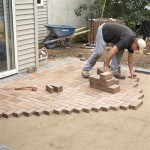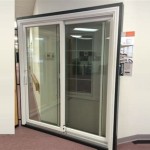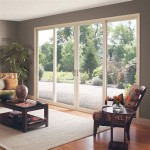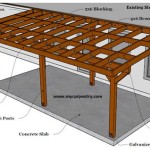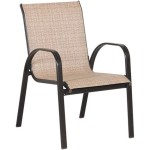```html
What To Do With A Small Patio
A small patio presents a unique set of design challenges and opportunities. Maximizing space, creating an inviting atmosphere, and ensuring functionality are key considerations. The approach to design should prioritize efficiency and clever use of vertical space, color palettes, and multi-purpose furniture.
Optimizing Space and Layout
The initial step in transforming a small patio is to meticulously analyze the available space. This involves noting the precise dimensions, considering any existing architectural features, and identifying potential obstructions such as doors, windows, or utility access points. Accurate measurements are crucial for planning furniture placement and determining the feasibility of various design elements.
The layout should aim to create the illusion of spaciousness. This can be achieved through several techniques. One effective method is to avoid clutter. Too many items can make the area feel cramped and disorganized. Instead, focus on selecting a few key pieces that serve multiple purposes.
Another important aspect of optimizing the layout is to consider the flow of movement. Ensure that there is enough room to comfortably navigate the patio without bumping into furniture or other obstacles. Pathways should be clear and unobstructed, allowing for easy access to and from the patio area. Diagonal layouts can sometimes create a sense of greater space compared to linear arrangements, but this depends on the specific shape of the patio.
Built-in seating can be a valuable space-saving solution. Benches or banquettes that are integrated into the patio's structure can eliminate the need for bulky chairs, freeing up valuable floor space. These built-in elements can also provide storage underneath, further maximizing the patio's utility.
Consider incorporating zoning to delineate different areas within the small patio. For example, one zone could be dedicated to dining, while another could be used for relaxation. This can be achieved through the strategic placement of furniture, rugs, or even potted plants. Defining zones can help to create a sense of order and purpose within the limited space.
Vertical Gardening and Greenery
When horizontal space is limited, vertical gardening offers an excellent way to introduce greenery and visual interest to a small patio. Various methods can be employed to create a lush and vibrant vertical garden. These include wall-mounted planters, hanging baskets, trellises, and living walls.
Wall-mounted planters are a simple and effective way to add greenery to a vertical surface. They come in a variety of sizes, shapes, and materials, allowing for customization to match the patio’s overall aesthetic. Choose plants that are well-suited to the patio’s sun exposure and climate.
Hanging baskets are another popular option for vertical gardening. They can be suspended from the patio’s roof, pergola, or even from specially designed stands. Hanging baskets are particularly well-suited for trailing plants, such as petunias, fuchsias, and ivy geraniums. Ensure that the hanging baskets are securely attached to prevent them from falling.
Trellises provide support for climbing plants, creating a living wall that can add privacy and shade to the patio. Trellises can be made from wood, metal, or even bamboo. Choose climbing plants that are appropriate for the patio’s climate and sun exposure. Popular options include climbing roses, clematis, and jasmine.
Living walls, also known as green walls, are more complex vertical gardening systems that involve attaching plants to a vertical structure with a growing medium. These systems can be either modular or custom-built. Living walls can create a striking visual impact and can also help to improve air quality. However, they typically require more maintenance than other vertical gardening methods.
When selecting plants for a small patio, consider their mature size and growth habits. Avoid plants that will quickly outgrow the available space. Opt for compact varieties that will thrive in containers or small spaces. Also, consider the patio’s sun exposure and choose plants that are well-suited to those conditions.
Beyond the purely aesthetic benefits, incorporating greenery can have a positive impact on the patio's microclimate. Plants can help to cool the air, reduce noise pollution, and attract beneficial insects.
Furniture and Accessories for Small Spaces
Selecting the right furniture is crucial for maximizing the functionality and comfort of a small patio. The key is to choose pieces that are appropriately scaled for the space and that serve multiple purposes. Avoid bulky or oversized furniture that will overwhelm the area.
Folding or stackable furniture is an excellent option for small patios. These pieces can be easily stored away when not in use, freeing up valuable space. Folding chairs and tables are particularly useful for accommodating guests or for creating a flexible dining area.
Multi-functional furniture is another important consideration. For example, a storage ottoman can provide seating, a place to rest your feet, and hidden storage. A coffee table with a lift-top can be used for dining or as a workspace. Benches with built-in storage are also a great way to maximize space.
When choosing furniture materials, consider the patio’s climate and the level of maintenance required. Weather-resistant materials such as teak, aluminum, and resin wicker are good options for outdoor use. These materials are durable and can withstand exposure to the elements.
Accessories can add personality and style to a small patio, but it is important to avoid clutter. Choose a few key accessories that will enhance the overall design without overwhelming the space. Consider incorporating outdoor rugs, throw pillows, and lanterns to create a cozy and inviting atmosphere.
Lighting is an essential element of patio design. String lights, lanterns, and candles can create a warm and inviting ambiance. Solar-powered lights are a convenient and energy-efficient option. Consider using spotlights to highlight specific features, such as plants or architectural details.
Mirrors can be used to create the illusion of greater space. Placing a mirror on a wall or fence can reflect light and make the patio feel larger. However, be mindful of what the mirror reflects. Avoid reflecting unsightly views or clutter.
Color palettes play a significant role in creating the desired atmosphere for a small patio. Light and neutral colors can make the space feel brighter and more spacious. Bold colors can add visual interest and personality, but they should be used sparingly. Consider incorporating pops of color through accessories such as throw pillows, planters, or artwork.
Ultimately, the best approach to designing a small patio is to carefully consider the available space, prioritize functionality, and create a cohesive design that reflects personal style. By employing clever space-saving techniques, incorporating vertical gardening, and selecting appropriate furniture and accessories, transform a small patio into a functional and inviting outdoor living space.
```
The Best Small Patio Ideas To Eoy This Summer

The Best Small Patio Ideas To Eoy This Summer

19 Patio Ideas For Small Outdoor Spaces Garden

50 Stylish Small Patio Ideas Designer Patios Tips And Tricks

95 Small Yet Cool Patio Decor Ideas Digsdigs

Best Small Outdoor Patio Ideas Forbes Home
:max_bytes(150000):strip_icc()/Screenshot2023-05-17at09-38-00POVPalmSpringsStaycation.HowItransformedmyBackyardintomyveryownDesertOasiswithWorldMarketBlancoBungalow-20a171b033654cbaa67542cccd99fb78.png?strip=all)
40 Statement Making Small Patio Ideas On A Budget

50 Stylish Small Patio Ideas Designer Patios Tips And Tricks

The Best Small Patio Ideas To Eoy This Summer

20 Brilliant Small Backyard Ideas
Related Posts

